Pearl gourami: features, maintenance and care
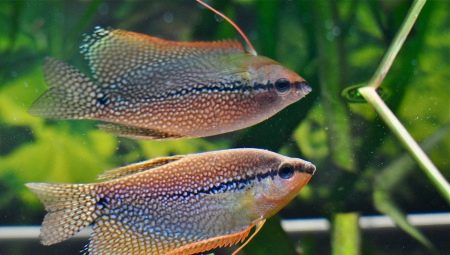
Pearl gourami is an amazingly beautiful species of fish, which is why it is loved by aquarists. The huge popularity is due to the ease of maintenance, good health and high decorative properties of fish.
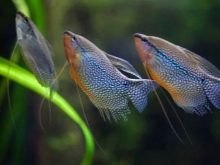
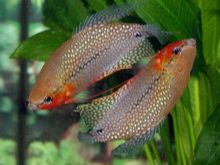

Description
Pearl gourami belongs to the category of specially protected species and is listed in the Red Book. The first description of fish was compiled by the scientist Blecker in 1852, and Thailand and the islands of Borneo and Sumatra are considered their homeland. The habitat of the species distribution in the natural environment is warm water bodies with an abundance of vegetation, located in the Malay Archipelago, Thailand and Indonesia.
Fish prefer acidic water with an abundance of vegetation, where they feed on insects, their larvae and zooplankton. The behavior of the gourami in the process of hunting for midges is interesting: the fish shoots a thin stream of water at the insects, knocks them into the water and eats them safely. For aquarium breeding, gourami are grown on special farms, since it is almost impossible to catch such a fish in a natural reservoir.
A distinctive feature of pearl gourami is their ability to breathe ordinary air, and not oxygen dissolved in water, like other fish. This type of breathing is due to the special structure of the breathing apparatus, which must be taken into account by the owners when transporting fish to the aquarium.
Another feature of pearl gourami is their ability to "build" nests from foam and grow their fry in them.


An interesting fact is the ability of females to emit distinct sounds during the spawning period, the nature of which is not fully understood. Males do not make any sounds during spawning, but they noticeably change. Their throats and belly take on a bright red hue, which makes them look much more attractive than females.
The body size of pearl gourami is not too large, and an adult rarely grows more than 12 cm. This allows them to be kept in medium sized communal aquariums with an abundance of algae and little swimming space. The body of the fish has an oblong shape and is somewhat compressed from the sides. The dorsal and anal fins have an elongated structure, which is especially noticeable in males.
The pelvic fins are especially sensitive and are designed for feeling underwater objects. They are framed with peculiar threads, which give the fish an unusual appearance. There are individuals with a disc-shaped body - pearl gourami balloons. Both are characterized by a silvery-violet, brown or red-brown color with an abundance of bright pearl dots located not only on the body, but also on the fins.
Pearl gourami are not too expensive: so, for an individual up to 3 cm in size, you will have to pay about 50 rubles, and a fish over 7 cm in length will cost 150 rubles.
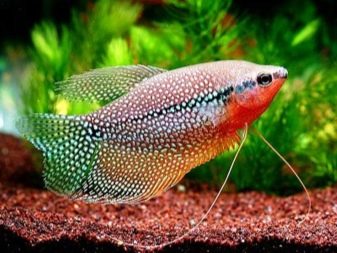

Compatibility
Sharing pearl gourami with other fish does not cause any problems. They get along well with all peaceful and non-aggressive fish that do not differ in territorial behavior and do not belong to the category of too large species. However, peaceful neighbors often become involuntary offenders of quiet and timid gourami. They mistake their filamentous fins for worms and often injure the fish. The ideal neighborhood is celebrated with neons, rainbows, battles and large shrimps.
The only thing to consider when growing gourami in a shared aquarium is their inability to compete for food. For this reason, you need to carefully monitor that the fish have time to eat well and no one bothers them.
In addition, if pearl gouramis are placed in already formed communities, then they will be frightened for a long time and hide in shelters until they realize that they are completely safe. As for incompatible species, then pearl gourami cannot be lodged with swordtails, goldfish, barbs, cockerels, haracinous and most cichlid species, with the exception of scalars.
In addition, it should be borne in mind that several types of gourami do not get along well with each other, they begin to arrange fights and conflict.
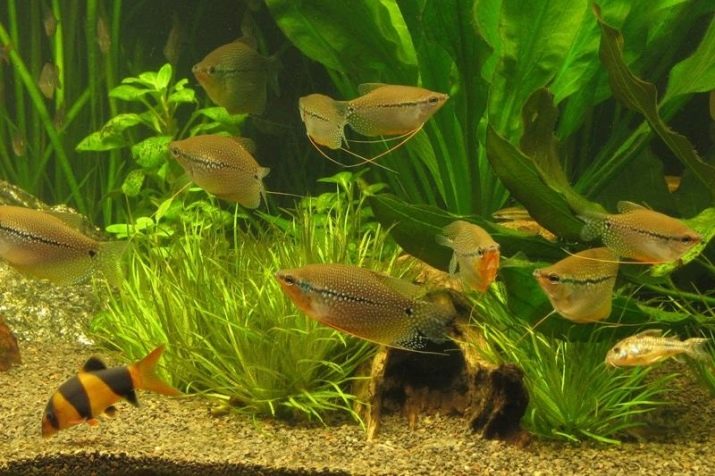
Growing conditions
Pearl gourami adapt well to new habitats and have a high survival rate. To do this, it is enough to follow the general rules of care and fulfill the requirements for the aquarium, water, soil and nutrition.
- When choosing a home aquarium it is advisable to purchase spacious tanks with a volume of at least 100 liters. Although the content of young animals is allowed in smaller containers, the fish grow quickly and require a full-fledged reservoir.
- Coarse river sand can be used as a soil, suitable for planting algae. Its layer should be 5-6 cm, which will allow the plants to form a strong root system.
- Plants for gourami should be branched and lush, as the fish likes to hide and build nests in dense thickets. For this, elodea and pinnate are well suited, and floating species, for example, duckweed, can be laid out on the surface of the water. However, you should not place too many floating plants, the fish should always have free access to air.
- After planting the vegetation, aquarium decorations are installed on the bottom, which at first will serve as a reliable refuge for timid and fearful pearl gourami.In addition to ready-made decor items, you can use coconut shells, driftwood, roots of an interesting configuration and ceramic pots.
- There are special requirements for water. Its temperature should be within + 24-28 degrees Celsius, the acidity level should be 6.5-8.5 pH, and the hardness should not exceed 15 dGh. In addition, taking into account the special type of respiration of pearl gourami, one should not allow too great a difference between the air and water temperatures.
- When choosing a filter, it is better to stay on a low-power model. This is due to the fact that gourami do not like strong currents, preferring to live in water with minimal movement.
- The illumination of the aquarium should be moderate. The fish does not like too bright light; in the wild, it prefers shady, overgrown with algae reservoirs.
- Water changes for gourami should be done once a week. and make up no more than 1/3 of the total volume of the aquarium. As a new portion, you should take settled filtered water with a minimum content of impurities of heavy metals and ammonia.

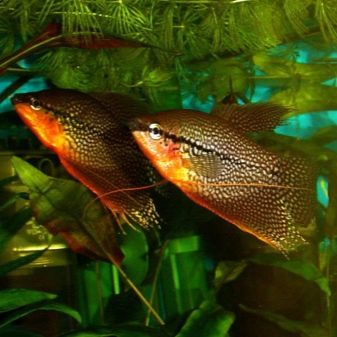
Feeding
Pearl gourami are omnivorous fish and feed on insects, their larvae and zooplankton in the wild. When kept in the aquarium, they accept any food of animal or vegetable origin, dry balanced mixtures and frozen cubes.
Gourami eat bloodworms, coretra, tubule, and brine shrimp well, and they use ready-made feed as a daily food. However, when choosing a feed, you need to pay attention to the size of the granules, acquiring fine-grained compositions. This is due to the small mouth of the fish, which is why they cannot swallow large particles.
A distinctive feature of pearl gourami is their ability to devour pests, namely hydras. These coelenterates enter the aquarium with food and cause irreparable harm to the community by eating fry. Gourami, on the other hand, deal with aggressors perfectly, leaving them not the slightest chance for salvation.
Pearl gourami are fed twice a day, but if you skip one of the feedings, the fish quickly find food in the aquarium. Without food, they can live up to 14 days.
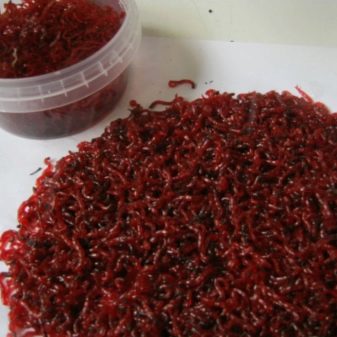
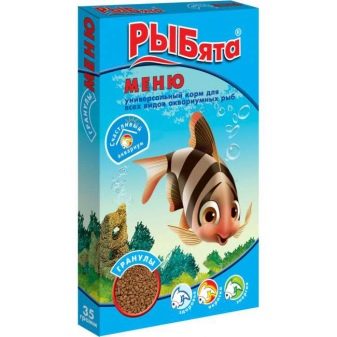
How to tell a male from a female?
Determining the gender of a pearl gourami is quite simple. Males and females differ markedly from each other, so it is almost impossible to confuse them:
- males are characterized by larger body sizes and elongated dorsal and anal fins;
- their color is much brighter than that of females, which makes males very attractive from a decorative point of view;
- the third difference lies in the color of the neck: for example, in females it is always orange, and in males it is bright red;
- Another difference is the caudal fin, which in males has a pointed shape, and in females it is smoothly rounded.
Thanks to these striking and obvious differences, it is not difficult to identify pearl gourami, and this can be done at any age.
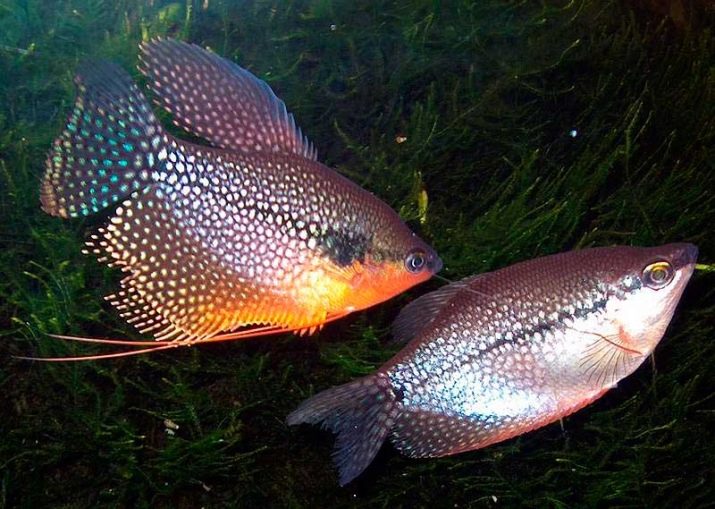
Reproduction
Breeding gourami does not require special knowledge and even a beginner can do it. However, for aquarists who do not have any experience in fish farming at all, it is advisable to become familiar with some of the rules and features of this process.
- You can get offspring both in a separate tank and in a common aquarium. However, the presence of neighbors can negatively affect the well-being of the fry, and if there is an opportunity to plant a pair in another container, you need to use it.
- A female and a male aged from 8 to 12 months showing signs of attention to each other are selected from the herd. and by the rounded abdomen it is determined whether the female is ready for spawning. The steam is carefully caught and transplanted into a separate container with a volume of about 30 liters. Many aquarists recommend dropping the male first and only a day later adding the female to him.
- The water during the spawning process must be crystal clear, and in order for the fish to feel more solitary, the aquarium is covered with a sheet of thick paper. A sandy soil is laid on the bottom and a Riccia plant, a natural material for building nests, is launched into the reservoir. The male quickly starts building the nest: he swallows air on the surface and releases small bubbles on the leaves of Riccia. Gradually, a large foam cap is formed on the surface of the leaf, the diameter of which is 5-7 cm, and the height often reaches 4 cm. It takes about a day for the male to arrange the nest, after which he kindly admits the female to him.
- The water level in the aquarium should not exceed 20 cm, and its hardness should be between 4 and 8 dGh. A special temperature regime is also required: a hot spawn is promoted by a water temperature of +29 degrees Celsius that is warmer than in a common aquarium.
- Due to the likelihood of destruction of the nest by a stream of water the use of aerators in the spawning grounds is not allowed.
- Before spawning, the couple should be fed exclusively with live food, excluding cyclops and daphnia from the diet. Otherwise, there is a high risk that young parents will devour their fry.
- Spawning itself lasts about 4 hours: the male pushes the female to the nest and, wrapping his body around her, squeezes out and fertilizes the eggs. Then he collects the eggs that did not fall into the nest, in the mouth he transfers them to the nest and glues them to the foam cap on saliva. During one spawning, the female is able to lay from 200 to 2000 eggs.
- As soon as the spawning process is completed, the female is placed in another container, and the male is left to take care of the offspring. The formation of larvae occurs on the third day, and on the fourth, the father of the family settles, and the fry begin to live independently. If this is not done, the male who is not fed throughout the entire period of caring for the offspring may simply devour the young.
- After the fry appeared, the liquid level in the reservoir is reduced to 6-8 cm and kept at this level for a month. This is necessary for the correct formation of the labyrinth respiratory apparatus in fry. If there are too many babies in the spawning grounds, it is recommended to additionally provide it with weak aeration.
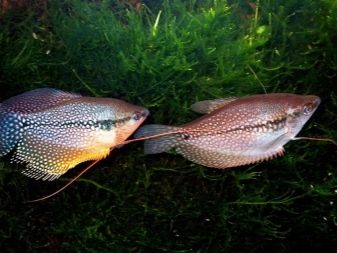
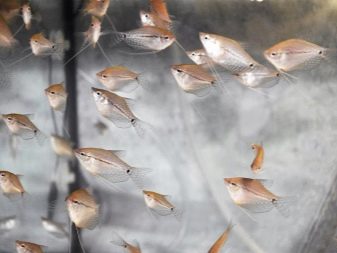
Ciliates, live dust and special feed are used as feed for young animals. In this case, it is necessary to ensure that uneaten excess food is removed from the aquarium in time and does not rot. And you also need to observe the behavior of large fry, which over time begin to eat smaller and weaker ones. This phenomenon occurs quite often and is due to the uneven growth of the livestock.
In such cases, things can be left to chance, resulting in large and strong individuals, or you can constantly arrange the livestock in groups, focusing on their size and behavior.
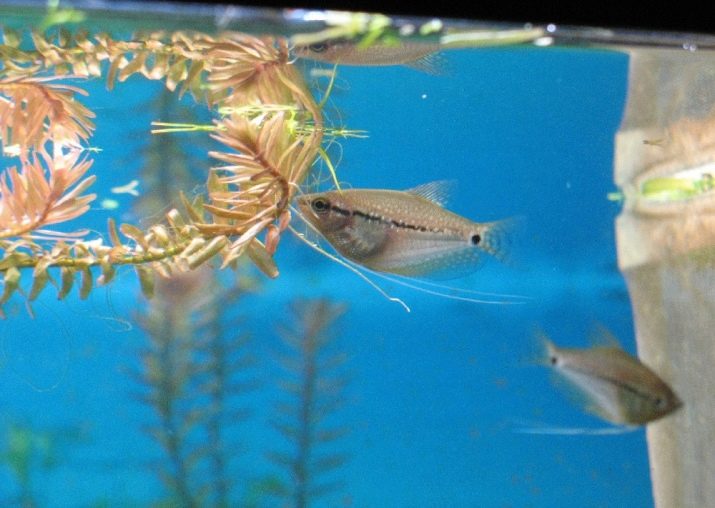
Life span
In aquarium conditions, pearl gourami live from 7 to 9 years. Fish are distinguished by strong immunity and very rarely get sick. Potential ailments are more likely to occur due to insufficient maintenance and overcrowding of the aquarium. Often, the factors that led to the disease are injuries during transportation or transplantation, violation of the temperature and acidity of water, excess or shortage of food, low-grade or contaminated food, as well as too cold room air temperature.
Severe ailments include lymphocytosis, aeromonosis and pseudomonosis., which are of a viral nature and are treated with special preparations and complete disinfection of the aquarium. The causes of infection are infected live food, soil affected by pathogenic flora and diseased plants, and diseases develop faster against the background of general pollution of the aquarium and low water temperatures. But if the aquarium care is carried out according to all the rules, and the diet is carefully selected, then pearl gourami practically do not get sick and do not cause any problems to their owners.
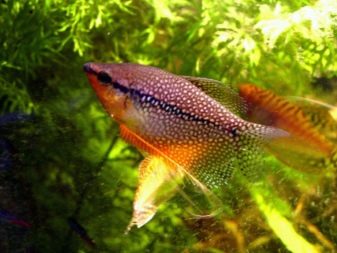

For more information about the features of these fish, see the next video.








